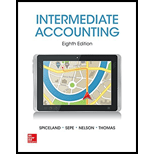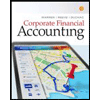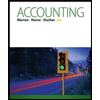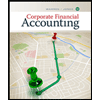
INTERMEDIATE ACCOUNTING W/CONNECT PLUS
8th Edition
ISBN: 9781259660429
Author: SPICELAND
Publisher: MCG
expand_more
expand_more
format_list_bulleted
Concept explainers
Question
Chapter 2, Problem 2.3BE
To determine
Accounting Cycle:
Accounting cycle refers to the process of recording a business transaction in the books of accounts. This cycle concludes when the financial statements are prepared.
T-account:
- T-account is the form of the ledger account, where the
journal entries are posted to this account. It is referred to as the T-account, because the alignment of the components of the account resembles the capital letter ‘T’. - The components of the T-account are as follows:
-
- a) The title of the account
- b) The left or debit side
- c) The right or credit side
To Post: The prepared journal entries to the T-accounts.
Expert Solution & Answer
Want to see the full answer?
Check out a sample textbook solution
Students have asked these similar questions
I need help solving this financial accounting question with the proper methodology.
Can you solve this general accounting question with accurate accounting calculations?
Triton Fabrication uses a predetermined factory overhead rate based on machine-hours. For March, Triton’s budgeted overhead was $144,000 based on a budgeted volume of 48,000 machine-hours. Actual overhead amounted to $138,000, with actual machine-hours totaling 50,500. What was over- or underapplied manufacturing overhead in March?
Chapter 2 Solutions
INTERMEDIATE ACCOUNTING W/CONNECT PLUS
Ch. 2 - Explain the difference between external events and...Ch. 2 - Each economic event or transaction will have a...Ch. 2 - What is the purpose of a journal? What is the...Ch. 2 - Explain the difference between permanent accounts...Ch. 2 - Describe how debits and credits affect assets,...Ch. 2 - Describe how debits and credits affect temporary...Ch. 2 - What is the first step in the accounting...Ch. 2 - Prob. 2.8QCh. 2 - Prob. 2.9QCh. 2 - Prob. 2.10Q
Ch. 2 - What is an unadjusted trial balance? An adjusted...Ch. 2 - Define adjusting entries and discuss their...Ch. 2 - Define closing entries and their purpose.Ch. 2 - Define prepaid expenses and provide at least two...Ch. 2 - Deferred revenues represent liabilities recorded...Ch. 2 - Define accrued liabilities. What adjusting journal...Ch. 2 - Prob. 2.17QCh. 2 - [Based on Appendix A] What is the purpose of a...Ch. 2 - [Based on Appendix B] Define reversing entries and...Ch. 2 - [Based on Appendix C] What is the purpose of...Ch. 2 - Prob. 2.21QCh. 2 - Transaction analysis LO21 The Marchetti Soup...Ch. 2 - Journal entries LO22 Prepare journal entries for...Ch. 2 - Prob. 2.3BECh. 2 - Journal entries LO22 Prepare journal entries for...Ch. 2 - Adjusting entries LO25 Prepare the necessary...Ch. 2 - Adjusting entries; income determination LO24,...Ch. 2 - BE2–7
Adjusting entries
• LO2–5
Prepare the...Ch. 2 - Prob. 2.8BECh. 2 - Prob. 2.9BECh. 2 - BE2–10
Financial statements
The following account...Ch. 2 - Prob. 2.11BECh. 2 - Closing entries LO27 The year-end adjusted trial...Ch. 2 - Prob. 2.13BECh. 2 - Prob. 2.1ECh. 2 - Prob. 2.2ECh. 2 - Prob. 2.3ECh. 2 - Prob. 2.4ECh. 2 - Prob. 2.5ECh. 2 - Debits and credits LO22 Indicate whether a debit...Ch. 2 - Prob. 2.7ECh. 2 - Prob. 2.8ECh. 2 - Prob. 2.9ECh. 2 - Prob. 2.10ECh. 2 - Prob. 2.11ECh. 2 - Prob. 2.12ECh. 2 - Prob. 2.13ECh. 2 - Prob. 2.14ECh. 2 - Prob. 2.15ECh. 2 - Prob. 2.16ECh. 2 - Prob. 2.17ECh. 2 - Prob. 2.18ECh. 2 - Prob. 2.19ECh. 2 - Prob. 2.20ECh. 2 - Reversing entries Appendix 2B The employees of...Ch. 2 - Prob. 2.22ECh. 2 - Prob. 2.23ECh. 2 - Special journals Appendix 2C The White Companys...Ch. 2 - Prob. 2.25ECh. 2 - Prob. 1CPACh. 2 - Prob. 2CPACh. 2 - 3. Compared to the accrual basis of accounting,...Ch. 2 - Prob. 4CPACh. 2 - Prob. 5CPACh. 2 - Prob. 2.1PCh. 2 - Prob. 2.2PCh. 2 - Prob. 2.3PCh. 2 - Prob. 2.4PCh. 2 - Prob. 2.5PCh. 2 - Prob. 2.6PCh. 2 - Prob. 2.7PCh. 2 - Prob. 2.8PCh. 2 - Prob. 2.9PCh. 2 - P2–10
Accrual accounting; financial...Ch. 2 - Prob. 2.11PCh. 2 - Prob. 2.12PCh. 2 - Prob. 2.13PCh. 2 - Judgment Case 21 Cash versus accrual accounting;...Ch. 2 - Judgment Case 2–2
Cash versus accrual...Ch. 2 - Communication Case 23 Adjusting entries LO24 I...
Knowledge Booster
Learn more about
Need a deep-dive on the concept behind this application? Look no further. Learn more about this topic, accounting and related others by exploring similar questions and additional content below.Similar questions
- Please explain the solution to this general accounting problem using the correct accounting principles.arrow_forwardFor the month ended February 29, 2024, Collins Manufacturing reported revenues of $78,500, expenses of $72,300, and dividends of $5,800. Collins Manufacturing experienced a net income or net loss of what amount?arrow_forwardQuilcene Oysteria farms and sells oysters in the Pacific Northwest. The company harvested and sold 8,000 pounds of oysters in August. The company's flexible budget for August appears below: Quilcene Oysteria Flexible Budget For the Month Ended August 31 Actual pounds (q) Revenue ($4.00q) Expenses: Packing supplies ($0.50q)) Oyster bed maintenance ($3,200) Wages and salaries ($2,900 + $0.30q) Shipping ($0.80q) Utilities ($830) Other ($450 + $0.05q) Total expense Net operating income The actual results for August were as follows: Quilcene Oysteria Income Statement For the Month Ended August 31 Actual pounds Revenue Expenses: Packing supplies Oyster bed maintenance Wages and salaries Shipping Utilities Other Total expense 8,000 $ 32,000 4,000 3,200 5,300 6,400 830 850 20,580 $ 11,420 8,000 $ 35,200 4,200 3,100 5,640 6,950 810 980 21,680 12 528arrow_forward
- What is the value of total assets?arrow_forwardI need assistance with this financial accounting question using appropriate principles.arrow_forwardVertex Industries bases its manufacturing overhead budget on budgeted direct labor-hours. The direct labor budget indicates that 8,200 direct labor-hours will be required in August. The variable overhead rate is $6.40 per direct labor-hour. The company's budgeted fixed manufacturing overhead is $145,000 per month, which includes depreciation of $13,500. All other fixed manufacturing overhead costs represent current cash flows. What should be the August cash disbursements for manufacturing overhead on the manufacturing overhead budget?arrow_forward
arrow_back_ios
SEE MORE QUESTIONS
arrow_forward_ios
Recommended textbooks for you
 Corporate Financial AccountingAccountingISBN:9781305653535Author:Carl Warren, James M. Reeve, Jonathan DuchacPublisher:Cengage Learning
Corporate Financial AccountingAccountingISBN:9781305653535Author:Carl Warren, James M. Reeve, Jonathan DuchacPublisher:Cengage Learning AccountingAccountingISBN:9781337272094Author:WARREN, Carl S., Reeve, James M., Duchac, Jonathan E.Publisher:Cengage Learning,
AccountingAccountingISBN:9781337272094Author:WARREN, Carl S., Reeve, James M., Duchac, Jonathan E.Publisher:Cengage Learning, Accounting (Text Only)AccountingISBN:9781285743615Author:Carl Warren, James M. Reeve, Jonathan DuchacPublisher:Cengage LearningCentury 21 Accounting Multicolumn JournalAccountingISBN:9781337679503Author:GilbertsonPublisher:Cengage
Accounting (Text Only)AccountingISBN:9781285743615Author:Carl Warren, James M. Reeve, Jonathan DuchacPublisher:Cengage LearningCentury 21 Accounting Multicolumn JournalAccountingISBN:9781337679503Author:GilbertsonPublisher:Cengage Corporate Financial AccountingAccountingISBN:9781337398169Author:Carl Warren, Jeff JonesPublisher:Cengage Learning
Corporate Financial AccountingAccountingISBN:9781337398169Author:Carl Warren, Jeff JonesPublisher:Cengage Learning

Corporate Financial Accounting
Accounting
ISBN:9781305653535
Author:Carl Warren, James M. Reeve, Jonathan Duchac
Publisher:Cengage Learning

Accounting
Accounting
ISBN:9781337272094
Author:WARREN, Carl S., Reeve, James M., Duchac, Jonathan E.
Publisher:Cengage Learning,


Accounting (Text Only)
Accounting
ISBN:9781285743615
Author:Carl Warren, James M. Reeve, Jonathan Duchac
Publisher:Cengage Learning

Century 21 Accounting Multicolumn Journal
Accounting
ISBN:9781337679503
Author:Gilbertson
Publisher:Cengage

Corporate Financial Accounting
Accounting
ISBN:9781337398169
Author:Carl Warren, Jeff Jones
Publisher:Cengage Learning